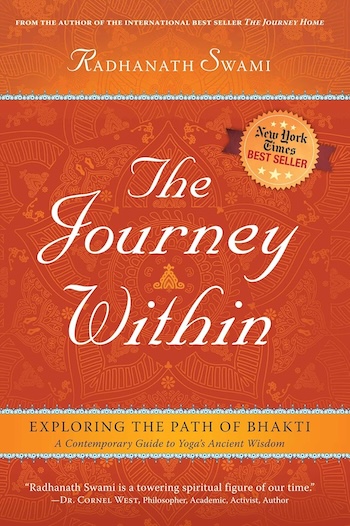By Elizabeth Reninger
In the same way that a bird requires two wings in order to fly, a human being requires both wisdom and compassion in order to soar through the skies of spiritual awakening.
This metaphor –- of a bird with his/her two wings — is used often by meditation and Yoga teachers, to help their students understand more clearly how wisdom and compassion, truth and love, must always work together: how neither can stand (not to mention fly!) on its own.
In this essay, we’ll explore two forms of yoga practice — Bhakti Yoga and Jnana Yoga — whose distinct approaches highlight these two important facets of the practice. And we’ll learn how each depends upon the other for our yoga practice to really “take flight.”
BHAKTI & JNANA: THE YOGAS OF DEVOTION & WISDOM
Bhakti Yoga – the Yoga of love/devotion – and Jnana Yoga – the yoga of knowledge/wisdom – are two of the four traditional paths of yoga.
The path of Bhakti Yoga is fueled by an intense devotion to the Divine – and can manifest also as love and devotion toward our spiritual teacher, and toward our friends and family members. When we’re practicing Bhakti Yoga, the emotional energy of love and compassion naturally nourishes acts of kindness and selfless service. Our heartfelt celebration of the wisdom, compassion, beauty, and power of the Divine (aka God, Spirit, Buddha-Nature, the Tao) includes the understanding that this Divine “energy” is what is shining through the eyes of each and every sentient being. So our service to “others” is actually a service to the Divine – our Beloved. And eventually, we come to understand that “self” and “other” are both, equally, expressions of this Divine: that in our essence we are not-two.
The path of Jnana Yoga, on the other hand, is rooted in understanding, wisdom, and insight. We connect directly with the Divine – the Truth of our innermost being – by dissolving all ignorance beliefs which previously were veiling this Truth. When we’re practicing Jnana Yoga, we likely will begin with conceptual explorations into the nature of reality: the reality of our perceptions, our thoughts, and our feelings. We engage our intellect in discerning what is real vs. what is unreal. Eventually, these conceptual explorations open into direct nondual insight: into the non-conceptual space of freedom beyond the mind. From this placeless place, we see clearly the non-separation between “self” and “other” – which is the direct and effortless experience of love and compassion.
So Bhakti Yoga – the path of love – and Jnana Yoga – the path of wisdom – both end in a union of wisdom and compassion: the two “wings” of spiritual awakening.
BODHICITTA: THE HEART-MIND OF AWAKENING
“Bodhicitta” is a Sanskrit term that’s often translated into English as “the heart-mind of awakening.” In Mahayana Buddhism, Bodhicitta refers to the wish to attain enlightenment not only for oneself – but instead for the benefit of all living beings. This deeply compassionate aspiration is rooted in wisdom: in letting go of the illusion of a separate, autonomous inherently-existing self. Bodhicitta comes in two varieties: Absolute and relative.
What’s known as “relative Bodhicitta” emphasizes what we typically think of as compassionate action: doing our best to reduce the suffering of others, via everyday friendliness, kindness, and skillful action. Absolute Bodhicitta, on the other hand, is rooted in nondual wisdom: the understanding that the root of all suffering is the mistaken belief in a separate self.
So Absolute and relative Bodhicitta – just like Jnana Yoga and Bhakti Yoga – form the “two wings” of wisdom and compassion – which allows the awakened mind to take flight.
WISE V. BLIND/IDIOT COMPASSION
If you’ve ever seen a bird with one of its wings injured, attempting to fly with only one wing – you know how awkward and ultimately impossible it is. And the same thing is true with compassion: without its second wing of wisdom, compassion is bound to be awkward and unsuccessful. As Buddhist philosopher Ken Wilber puts it:
“Real compassion includes wisdom and so it makes judgments of care and concern; it says some things are good, and some things are bad, and I will choose to act only on those things that are informed by wisdom and care.”
In terms of our daily lives, what this means is that there is no formula for what “compassionate action” looks like. Wise compassion sees the big picture and acts in accordance with moral principles and clear wisdom/insight. Only then – when the wing of compassion is joined by the wing of wisdom – can our daily actions and spiritual practice attain the heights of true realization and be of greatest benefit to all.
ABOUT THE AUTHOR:
Elizabeth Reninger is a poet and longtime yoga practitioner. She holds a Master’s degree in Oriental Medicine and is passionate about creating harmony at the level of the body and mind and enjoying our shared essence as Pure Awareness. To learn more about Elizabeth’s work/play, please visit her website: elizabeth-reninger.com
YOU MAY ALSO LIKE:
HOW THE US HAS CHANGED THEIR EATING HABITS OVER THE YEARS
By Kevin Jones It’s no secret that the U.S. is one of the most overweight countries in the world. With 34.3 percent…
BENEFITS AND USES OF OREGANO
Best known for serving as a delicious addition to Italian fare, Oregano possesses far-reaching benefits that go well beyond the kitchen….
WHAT YOU NEED TO KNOW ABOUT YOUR THROAT CHAKRA
Do you feel stuck in your vocal expression, have a hard time expressing yourself verbally or experience difficulty speaking up for…
THE BRAIN-BOOSTING POWERS OF LION’S MANE MUSHROOM
Among medicinal mushrooms, Lion’s Mane (Hericium erinaceus, in Latin) is one of the most beautiful: its inspiring cascade of furry-white filaments…
WHAT ARE CHERRIES GOOD FOR?
Cherries are packed with healthy nutrients, minerals, vitamins, and antioxidants. Their low-calorie content makes them a perfect snack that you can…
COLOSTRUM BASICS: WHAT IS IT & WHY IS IT USED AS A SUPPLEMENT? (PART ONE)
While it may seem strange for humans to use bovine (i.e., cow) colostrum as a supplement, there are many excellent reasons…










